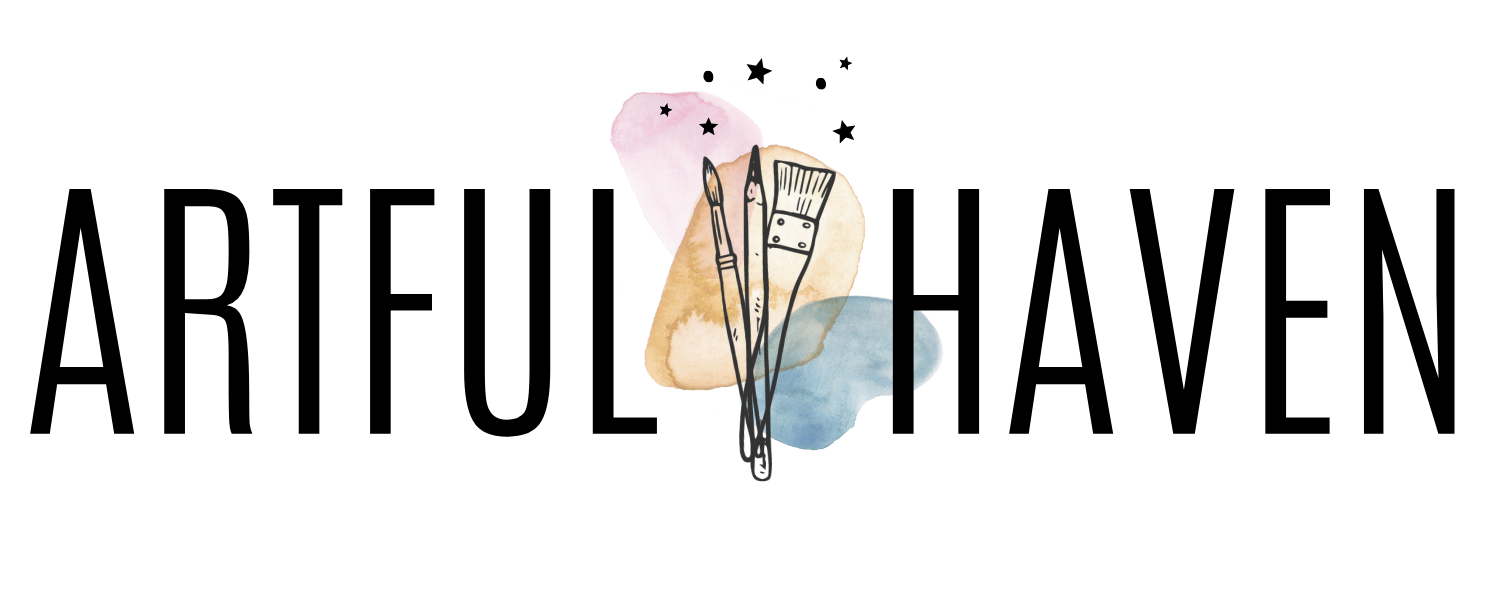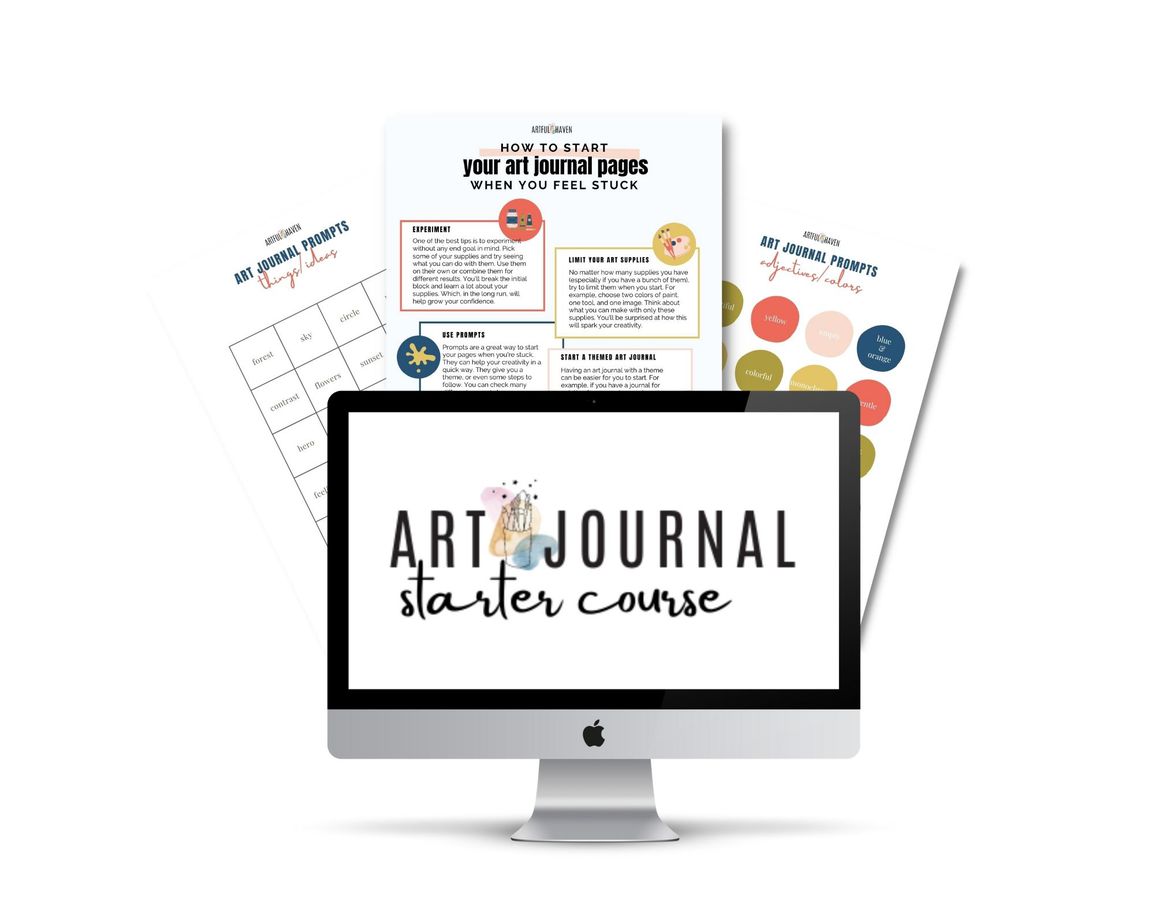How To Include Nature In Art: Easy Ideas For Drawing And Painting
If you include nature in your art journaling, you’ll immediately discover how you become more grateful and aware of your surroundings. You’ll learn to appreciate the beauty and the life the Earth provides.
Nature makes us happy. Period.
Art makes us happy. Period.
Combine the two and it’s like winning the lottery. You gain so much.
According to the UK’s nature challenge in 2016, nature makes us healthier and happier. Their one-month experiment proved it. They found that “people with a stronger connection to nature experienced more life satisfaction, positive affect, and vitality.”
The feeling is priceless because nature gives us peace that modern life is taking from us more and more every day.
So, how to hold on to that feeling a bit longer after we come back to concrete pavements and busy streets? Nature journaling.
How is art related to nature?
When I think of nature, I immediately think of trees, meadows, flowers, waterfalls, mountains, and our planet Earth in the vast universe. They are all connected and related to one another.
Nature has inspired artists for centuries, ever since humans started walking this planet. It is not surprising at all because natural things have this perfect balance that we humans seek in our everyday lives.
Right at this moment, I’m having an image in my mind of a vast horizon perfectly designed and a feast for the eyes.
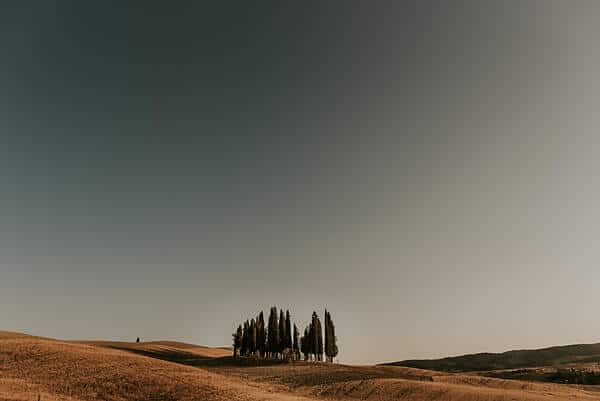
Isn’t that a work of art? So, it’s no wonder nature inspires us over and over again. Its inspiration is endless and affects each of us in a different way. That’s why we constantly create art inspired by natural beauty.
How to find inspiration in nature
Nature can inspire you in many ways. Why not use some of them to make your art even more creative? Here are some ideas on using nature to create in your art journal.
Experience the silence of nature
One of the greatest moments for inspiration in nature is silence. Think about it, when you’re sitting on the grass, looking at the mountains, or a river, being far away from civilization, nothing strikes you as the silence nature provides. Then you can close your eyes and really get lost within yourself.
If you make art after or during a moment like this, you’ll see how nature has overwhelmed you and inspired you to look deep and find what’s been blocked or hidden.
Meditation in nature
These moments of silence I’ve mentioned above are a perfect opportunity to meditate and ask for more creativity in your life.
So, next time you have this moment, close your eyes and listen to your surroundings. Maybe you’ll hear birds or a river, whatever it is, just give it a bit of attention and embrace it.
Become aware of the calmness and balance around you. Breathe in the atmosphere and I promise you’ll have a smile on your face. A genuine one.
Next, say a positive affirmation for more creativity in your life. For example:
I find creativity in nature all the time.
Nature inspires me to create amazing art.
I trust nature to inspire me to make art.
So, write your affirmations in your journal and make some art around them. Look around, there must be something that catches your eye, like a flower or a bird. Explore that in your art journal.
If meditation in art journaling made you curious, read more info on positive affirmations and art journaling in this post.
Make pressed flowers and leaves
I use these for decorating my pages. They give my art journal pages a unique and fresh look (yes, despite the fact they are dried).
What to do with pressed flowers and leaves?

After they’ve been pressed, they lay flat so you can put them in your journal easily. You can use washi tape to glue them down or use liquid glue drops on the back and stick them on the page.

I also love to dry flowers and use them as photo props or just as decoration in my vases.
If you collect a bunch of different leaves and flowers, you can create amazing collages. For example, use them to make a human figure, a ballerina dancer, a crazy face, or a symmetrical face.
Look through your stash and see if you can use them together to create a unique image that is the result of your wonderful imagination.
Things to draw in your art journal
You can use anything you like in nature and draw it in your journal. The possibilities are endless. For example, you can draw a big picture like a whole tree or a forest, or you can take a pattern or a small piece of a leaf and transform that into a drawing.
The thing is, you start noticing new things when you look at natural surroundings with more insight and fresh eyes. And then, you realize how beautiful and perfect the trees are, the stars, or even a dry desert.
Flower drawing
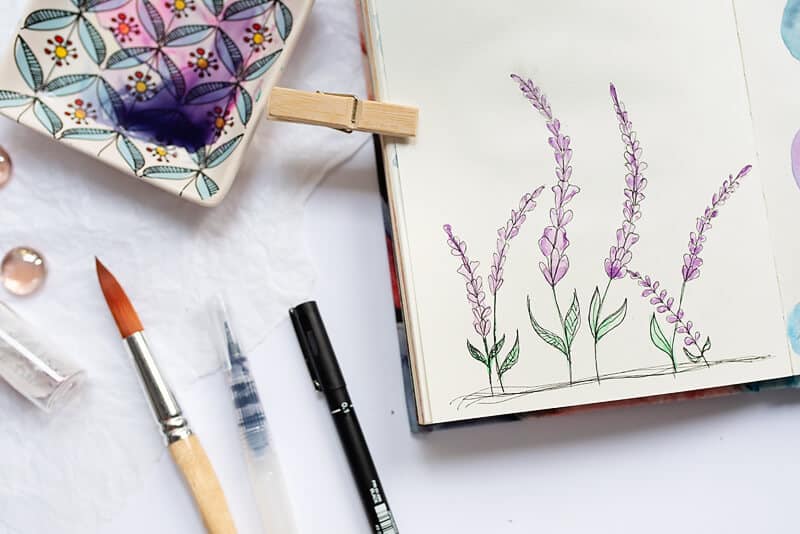
Well, what can compete with the beauty of a flower? There are so many different ones that I feel we can draw inspiration from them endlessly.
Try to look at the flowers more carefully than usual. When you draw them, think about the main parts like the stem, leaves, petals, and pistil. I prefer drawing the stem first and then continuing upwards.
You discover what way you like, it’s about experimenting and having fun. Please don’t seek perfection, because things in nature are also crooked and asymmetrical, but still beautiful.
Think about some of these:
Does the flower grow alone or in groups?
Is the stem long or short, thick or thin?
Does it have many leaves or just a few?
How are the petals arranged? Look at how close the petals are to one another. Are they bent or flat? Also, look for creases on the petals. If you draw lines where the petals curve or crease, you’ll get a sense of depth and movement.
Look at the parts that are in the shade. If you want to paint the flower, then shading will give it a more realistic look.
What about the pistil? Is it big or small? Is it visible or hidden behind the petals?
What color are the petals?
Create imaginary flowers
Another idea is to mix two or more flowers and create a new one only from your imagination. For example, take the petals from one flower, a stem from another, the leaves from the third one. Or let nature inspire you to create a flower that’s entirely from your imagination.
Patterns in nature

Nature is filled with patterns you can copy into your journal.
For example, you could notice the pattern of a bunch of stones together in one place. Or the pattern leaves make in a tree.
I was in the mountains not so long ago, and from up there I saw the hills and the mountains stacked together in a beautiful pattern.
If you look closely, you’ll surely find patterns everywhere. So, let them inspire you.
Painting with nature
Since I love experimenting in my art journals, I collect different things I find in nature and use them to paint. Painting with natural materials is so much fun because you never know what you’ll get. These things are unpredictable and that’s why painting with them is amazing.
I mostly collect flowers and leaves for this purpose, but lately, I’ve been using flowers for decoration and I experimented with painting with leaves.
How to paint with leaves
I’ve tried several nature journaling techniques that I’m gonna share with you today:
- Stamping with leaves
- Negative painting with spraying
- Leaf rubbing
- Leaf rubbing + resist technique
- Leaf tracing
1. Stamping with leaves
If you love stamping, this one is perfect for you. You’ll get an interesting effect and texture.
What you’ll need are a fresh leaf and some acrylic paint.

Put the acrylic paint on the bottom side of the leaf, where all its texture lives. I usually put the paint only with my fingers. The messier, the more fun! Don’t be afraid to put a good amount of paint.

Next, stamp with it on the paper. Press the leaf with your fingers as you would with an ordinary stamp.
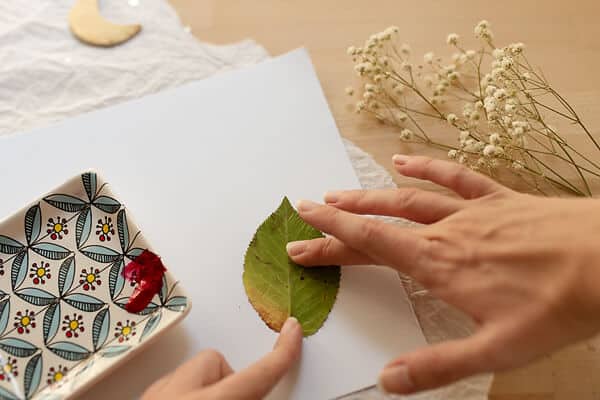
And voila! I love this. You can make a background with this technique, or paint a whole plant just by stamping.

2. Negative painting with spray inks
This is even messier so be sure to make some space and protect your desk if you don’t like ink splashes all over.
First, put the leaf on the paper or journal page. Then spray from above and let it stay for a few moments.

You could also put a sheet of paper or a paper napkin on top to absorb the excess liquid. If you do this, the leaf might get stuck on the napkin, so be sure to take it off carefully and slowly.
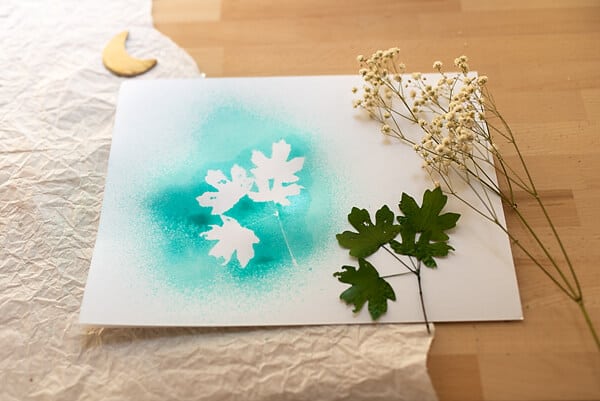
When it’s dry, you can trace the image with a pen or leave it as it is. Another idea is to doodle inside or outside the negative white space.
Remember, do this technique only if your art journal has thicker pages, otherwise use gesso to prime it or glue two or more pages together. If you put a lot of liquid by spraying like this, the thin paper will crumple and bleed.
3. Leaf rubbing
I used to do this all the time when I was a kid. It’s a way of transferring the texture onto the paper by rubbing over it with a pencil or a crayon.
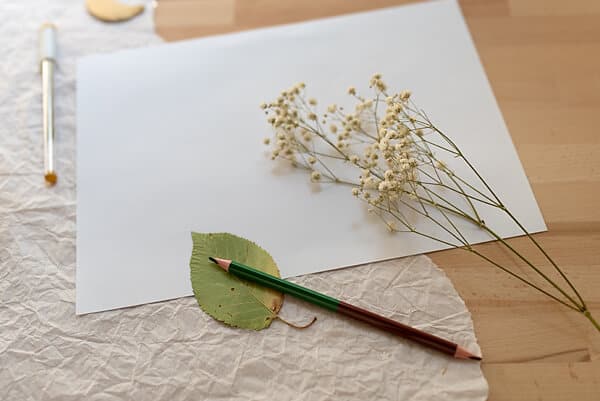
So, place the leaf bottom-up where there’s texture, cover it with paper and go over the paper with a pencil or a colored pencil. Experiment with the pressure to see what works the best.
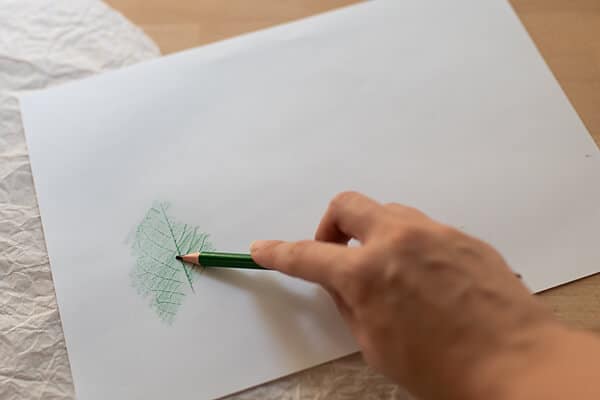
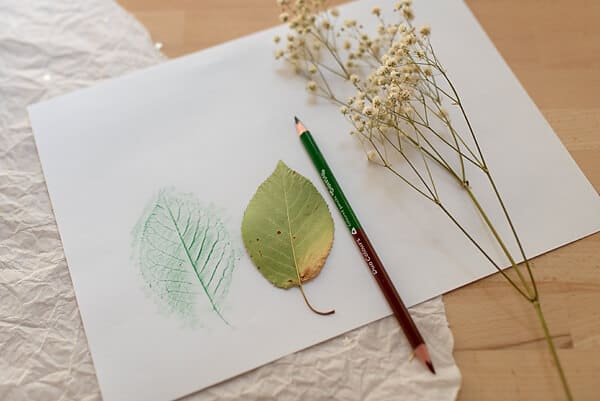
If you use thin paper, you’ll need light pressure but the thicker the paper, the more pressure you’ll need. That’s why the leaf’s texture is best visible on a thinner paper.
Later, you can cut these out and glue them in your art journal.
4. Leaf rubbing + resist technique
You do the same as in leaf rubbing above, just use the wax crayon to do it. The wax in crayon resists paint so the effect can be pretty neat.
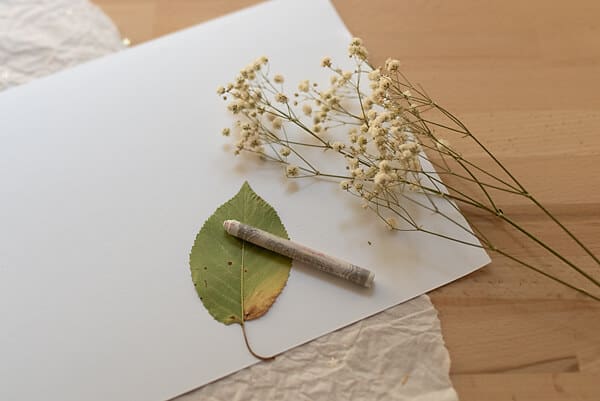
I used a white crayon and made a pencil mark to know where my leaf is under the paper.

Then I used watercolor on top, let it sit for a few seconds and gently dab the liquid with a paper towel. I repeated the process until I saw white markings of the leaf underneath.

Wonderful!
5. Leaf tracing
Well, we all did this in childhood years. Why not do it again? It’s fun and carefree.

My leaf here is an ordinary leaf you can find everywhere, but if you find a leaf with an interesting shape, this tracing technique could really be something!
Find inspiration in quotes about nature
Quotes are one of my favorite things to include on a page. They are inspirational and insightful. Use them in your art journal to make the pages even more personal.
I’ve collected some nature quotes that you might like. Also, I included some of these in the free nature journal printable (get it at the bottom).
Adopt the pace of nature: her secret is patience.
Ralph Waldo Emerson
All my life through, the new sights of Nature made me rejoice like a child.
Marie Curie
The tree which moves some to tears of joy is in the eyes of others only a green thing that stands in the way. Some see nature all ridicule and deformity… and some scarce see nature at all. But to the eyes of the man of imagination, nature is imagination itself.
William Blake
Nature is so powerful, so strong. Capturing its essence is not easy – your work becomes a dance with light and the weather. It takes you to a place within yourself.
Annie Leibovitz
One touch of nature makes the whole world kin.
William Shakespeare
For in the true nature of things, if we rightly consider, every green tree is far more glorious than if it were made of gold and silver.
Martin Luther
Create art inspired by nature

Feeling inspired? Wanna run off to a river bank and have some alone time with nature? I dig you. And you should do it. Every chance you get.
Next time you go, take your art journal with you and let nature inspire you.
When you’re there, look at flowers, leaves, trees, clouds, patterns, colors, etc. Really look at them. Notice the details and the connections between them.
Also, collect flowers and leaves to use in your journals or to paint with them. Even better, experiment with paints and come up with your own ideas.
You can even try and keep a separate nature journal, only for this purpose. Use it to reflect on how natural places make you feel, and how nature inspires you to be grateful.
Above all, use nature journaling to become more grateful for all the beauty around you, because nature is deeply rooted in all of us, and we should appreciate everything it gives us.
